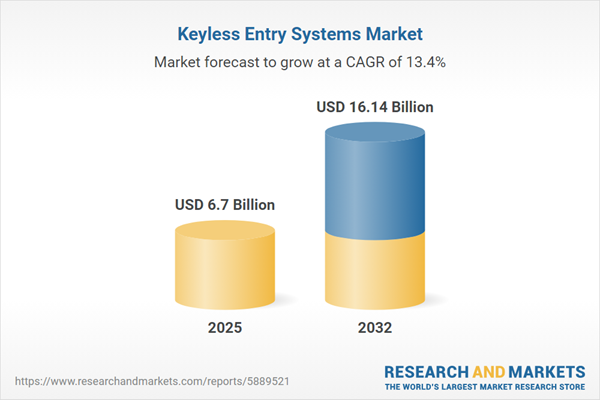Speak directly to the analyst to clarify any post sales queries you may have.
Keyless entry systems are reshaping enterprise security management by delivering flexible, scalable solutions tailored for organizations navigating complex regulatory demands. These technologies empower senior leaders to enhance oversight, manage evolving threats, and ensure efficient, compliant operations across diverse environments.
Market Snapshot: Keyless Entry Systems Market Growth
The keyless entry systems market is entering a sustained phase of expansion, driven by advanced security integrations in automotive, commercial, and residential sectors. Current industry forecasts project significant market size increases underpinned by robust CAGR. The rise in demand for flexible, wireless, and mobile-enabled solutions reflects an enterprise shift toward connected, agile security frameworks. As businesses intensify their focus on secure access and regulatory compliance, digital deployments are increasingly central. These standards enable organizations to roll out solutions quickly while preserving operational scalability, performance, and oversight—essential for managing distributed and complex business models.
Scope & Segmentation
- Application Areas: Automotive environments embrace biometric recognition, Bluetooth, NFC, Wi-Fi, and RFID to optimize access controls and streamline vehicle and fleet management. Commercial enterprises implement centralized credential platforms to facilitate unified oversight and simplify compliance across numerous sites. Residential operators leverage smart locks and remote platforms, increasing convenience for property managers and enhancing granular control options for security-focused roles.
- End Users: Aftermarket upgrades let enterprises extend the utility of legacy systems cost-effectively, avoiding complete replacement. OEMs incorporate high-grade security directly during production, supporting seamless integration and establishing a baseline for next-generation access control from deployment.
- Distribution Channels: Certified channel partners and installation specialists deliver tailored, enterprise-scale deployments for organizations with complex requirements. Remote purchasing tools increase scalability and efficiency for enterprises operating multiple or geographically dispersed facilities.
- Regional Coverage: Regional variations stem from differences in local infrastructure and compliance obligations. Vendors customize products to address unique regulatory and connectivity contexts across the Americas, EMEA, and Asia-Pacific, guiding adoption and system design to match in-market needs.
- Leading Companies Analyzed: The competitive landscape benchmarks Robert Bosch GmbH, ASSA ABLOY AB, Continental AG, Valeo SA, Allegion plc, dormakaba Holding AG, Denso Corporation, Stanley Black & Decker Inc., Honeywell International Inc., and Aisin Seiki Co., Ltd. Each is assessed for reliability and effectiveness in large-scale enterprise applications.
Keyless Entry Systems: Strategic Takeaways for Decision-Makers
- Adopt wireless, mobile, and biometric access methods to enhance future readiness and maintain consistent, versatile security for both centralized and remote operations.
- Implement retrofit initiatives to extract more value from existing infrastructure, enabling access control progress without significant system overhaul or disruption to operations.
- Partner with vendors providing secure digital credentialing, robust privacy protocols, and dynamic compliance tools to align access solutions with changing global and regional regulations.
- Engage with specialist hardware and software firms for customized solutions that maximize operational efficiency and streamline organization-wide access management workflows.
- Utilize app-based controls, voice recognition, and real-time monitoring features to heighten security oversight for distributed teams and locations.
Tariff Impact: Navigating U.S. Trade Policy and Supply Chain Changes
Recent U.S. tariffs on semiconductors and wireless components are affecting procurement and supply chain strategies. Enterprises are increasing investments in domestic assembly and looking to diversify distribution paths, seeking to reduce exposure to logistics disruptions. While larger organizations enhance vertical integration for greater control, smaller businesses adapt inventory and compliance methods, supporting enterprise stability and operational adaptability amid evolving trade scenarios.
Methodology & Data Sources
This report is built on thorough desk research and targeted interviews with senior professionals from automotive, commercial, and residential sectors. Rigorous validation of procurement and logistics data ensures the results address the needs of executive audiences focused on advancing their keyless entry initiatives.
Why This Report Matters
- Enables technology and risk leaders to align access control strategies with rapidly evolving security, compliance, and operational priorities.
- Provides evidence-backed guidance for procurement, infrastructure decision-making, and long-term planning—supporting improvements to secure access on an enterprise scale.
- Offers actionable frameworks that help organizations manage and protect access points across complex and widespread operational footprints.
Conclusion
This analysis empowers senior executives to advance enterprise access management practices, strengthen control across all environments, and safeguard business resilience as operational demands continue to evolve.
Additional Product Information:
- Purchase of this report includes 1 year online access with quarterly updates.
- This report can be updated on request. Please contact our Customer Experience team using the Ask a Question widget on our website.
Table of Contents
3. Executive Summary
4. Market Overview
7. Cumulative Impact of Artificial Intelligence 2025
Companies Mentioned
The companies profiled in this Keyless Entry Systems market report include:- Robert Bosch GmbH
- ASSA ABLOY AB
- Continental AG
- Valeo SA
- Allegion plc
- dormakaba Holding AG
- Denso Corporation
- Stanley Black & Decker, Inc.
- Honeywell International Inc.
- Aisin Seiki Co., Ltd.
Table Information
| Report Attribute | Details |
|---|---|
| No. of Pages | 183 |
| Published | October 2025 |
| Forecast Period | 2025 - 2032 |
| Estimated Market Value ( USD | $ 6.7 Billion |
| Forecasted Market Value ( USD | $ 16.14 Billion |
| Compound Annual Growth Rate | 13.3% |
| Regions Covered | Global |
| No. of Companies Mentioned | 11 |









